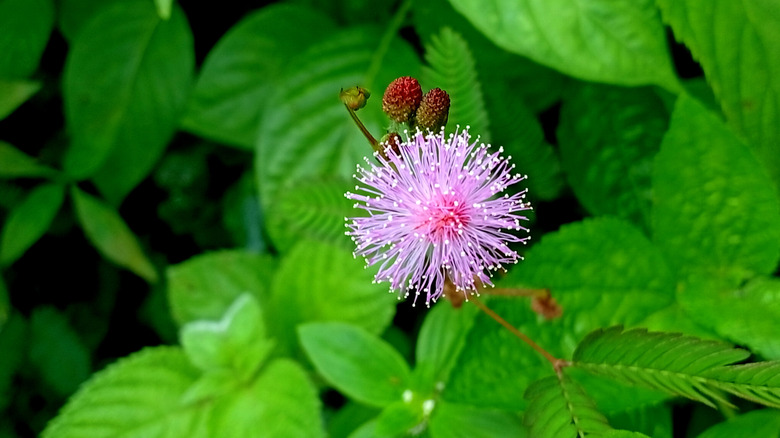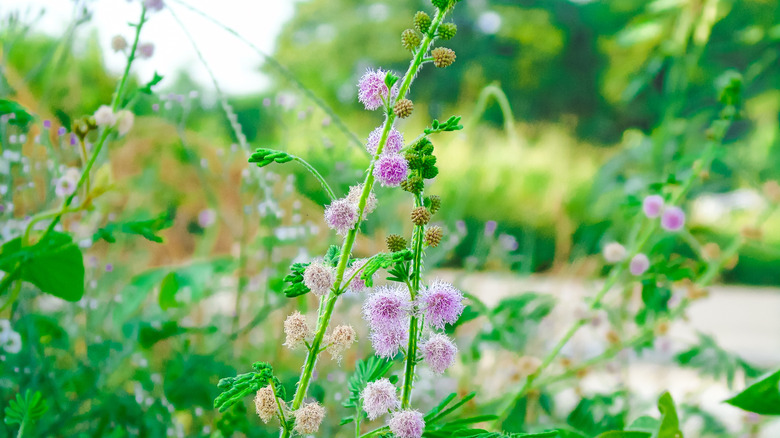The Unique Weed That's Catching The Attention Of Gardeners In The Southern US
Feel a bit socially awkward sometimes? Then you've got a lot in common with one curious little plant. It's called Mimosa pudica, but it goes by the common name of shameplant or sensitive plant, thanks to its aversion to the human touch. If you run your fingers along the green leaves of this weed, they immediately curl inward in response. Experts aren't entirely sure why this happens, but theorize it could be to ward off predators who would be startled by the rapid movement or change in appearance.
It's quite a unique trait, and shameplant also exhibits attractive, pink pincushion blooms. The combo makes it a perfect houseplant for growing indoors, and it can also be contained in mild climates. But outdoors in hot and humid areas like the southern United States, it's a different story. There, shameplant is catching the attention of gardeners because, despite its shy nature, it spreads fast and becomes invasive. It's also an aggressive and competitive plant, meaning that it will take precious resources and nutrients from neighboring plants to keep growing. For that reason, many southern gardeners are adopting strategies to stop shameplant in its tracks.
Stopping the shameplant spread
Shameplant doesn't need much to grow, and can withstand pretty harsh soil conditions (though it does best in humid climates). Additionally, it produces tons of seeds — as many as 700 in one plant. Those seeds are built for travel, thanks in part to clinging burrs that can stick to animals or people, who become unwitting carriers of the weed. All that resilience means that if you really want to get ahead of a shameplant invasion, you have to do a thorough job.
If you do spot it, you can pull it out by the roots — but note that the plant can spread through root fragments, so you have to do some digging to ensure you uproot the entire system. This can also get tricky when the plants get older, with woodier stems. Doing this as soon as you spot the plant and while soil is moist can help the effort. Keep in mind that the stems can be prickly, so be sure to choose the best gardening gloves for the job.
Another option is to manually remove the seed pods from the plant — the pods are fuzzy, brown, and pretty easy to spot. You can snip them with gardening shears. Just remember that given the sheer amount of seeds in the plant, you may need to supplement with hand weeding. If you use herbicides in your garden, shameplant is also susceptible to picloram, and triclopyr solutions, but make sure you follow the precise directions when using chemicals.
Additional steps for containing shameplant
Whichever method you choose, be mindful of how you dispose of the discarded shameplant. If you're uprooting it or cutting off seed pods, take measures to ensure the plant's seeds don't disperse throughout the process. For instance, you can gingerly snip the seed pods off the plant before you uproot it. And while there are benefits to composting at home, it's best to keep this one out of any compost mix that could eventually make it back to your garden.
Additionally, keep in mind that early detection is key to controlling the invasive spread of shameplant. Otherwise, it can get too out of control to handle with a little weeding. Thankfully, since shameplant sprouts its unique fluffy pink flowers, it typically isn't too tough to spot. By prioritizing its speedy removal and vigilantly monitoring for future outbreaks, you will likely be able to mitigate the spread of this one-of-a-kind plant.


